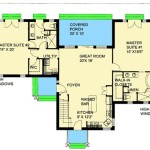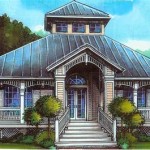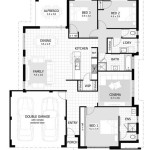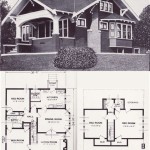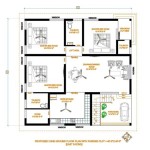House Plans For A Pie Shaped Lot
Pie-shaped lots, also known as fan-shaped or wedge-shaped lots, present unique architectural challenges and opportunities. These lots are wider at the rear property line and narrow towards the street, resembling a slice of pie. Successfully designing a house for this type of lot requires careful consideration of setbacks, easements, privacy, and maximizing usable space. Choosing the right house plan is crucial to turning these potential limitations into attractive features.
A comprehensive understanding of the lot's dimensions, angles, and restrictions is the first step. Local zoning regulations dictate minimum setback requirements from property lines, which significantly influence the buildable area. Easements, which grant rights of way to utility companies or neighbors, further limit construction options. Failure to comply with these regulations can lead to costly rework or legal issues. A professional land survey is highly recommended to accurately map the lot and identify any potential challenges before committing to a specific house plan.
Beyond the technical aspects, aesthetic considerations play a significant role in the overall design. The pie-shaped configuration offers design flexibility, allowing for unique architectural styles and features. Careful planning can enhance curb appeal, maximize natural light, and create private outdoor spaces. This article will explore various house plan strategies tailored for pie-shaped lots, focusing on optimizing space utilization, addressing privacy concerns, and creating visually appealing designs.
Maximizing Usable Space on a Pie-Shaped Lot
One of the primary challenges in designing for a pie-shaped lot is maximizing the usable space within the constraints of the lot's geometry. Traditional rectangular house plans are often inefficient, resulting in wasted space or awkward layouts. Therefore, adapting or creating custom house plans is essential to optimize the building footprint.
One effective strategy is to orient the house along the longest side of the lot, typically the rear property line. This configuration allows for a wider facade at the back, providing more space for living areas, bedrooms, and outdoor amenities. The narrower front of the house can accommodate garages, entryways, and less frequently used spaces. By strategically positioning the house, the available space can be efficiently utilized, minimizing wasted areas and creating a more functional layout.
Angled walls can also be incorporated into the design to follow the lot's boundaries. This approach allows for a more organic and flowing floor plan, maximizing the interior space while adhering to setback requirements. Angled walls can create unique architectural features, such as bay windows or recessed niches, adding character and visual interest to the house.
Another crucial aspect of maximizing space is the strategic placement of multi-story elements. By building upwards, the footprint of the house can be reduced, freeing up valuable ground space for outdoor living areas or landscaping. However, careful consideration must be given to the overall aesthetic and the impact on neighboring properties. Building height restrictions and neighborhood covenants may limit the number of stories or the overall height of the house.
Interior space planning should also prioritize functionality. Open-concept layouts can create a sense of spaciousness and improve traffic flow. Strategic placement of windows and doors can maximize natural light and connect interior spaces with the outdoors. Built-in storage solutions, such as cabinets and shelves, can help minimize clutter and maximize usable space within the house.
Consider the placement of the garage. Depending on the lot dimensions and zoning regulations, the garage can be positioned at the front, side, or rear of the house. A front-facing garage can be convenient for access but may detract from the curb appeal. A side-entry garage can be more visually appealing but may require a longer driveway. A rear-entry garage can maximize the front yard space but may require additional grading and excavation.
Ultimately, maximizing usable space on a pie-shaped lot requires a combination of careful planning, innovative design solutions, and a thorough understanding of the lot's specific characteristics. By tailoring the house plan to the unique constraints and opportunities of the lot, it is possible to create a functional, comfortable, and aesthetically pleasing home.
Addressing Privacy Concerns on a Pie-Shaped Lot
Privacy can be a significant concern on pie-shaped lots, particularly if the lot is located in a densely populated area. The wider rear of the lot often exposes the backyard to neighboring properties, potentially compromising privacy and reducing the enjoyment of outdoor spaces. Therefore, privacy considerations should be integrated into the house plan from the initial design phase.
Strategic landscaping is one of the most effective ways to enhance privacy on a pie-shaped lot. Planting trees, shrubs, and hedges along the property lines can create a natural screen, blocking views from neighboring properties and providing a sense of seclusion. Evergreen trees are particularly effective, as they provide year-round coverage. However, it is essential to choose plants that are appropriate for the local climate and soil conditions, and to ensure that they do not obstruct views or encroach on neighboring properties.
Fencing is another common method for enhancing privacy. A solid fence can provide a physical barrier, blocking views and reducing noise. The height and style of the fence should be chosen carefully to comply with local regulations and complement the overall aesthetic of the house. In some cases, a combination of fencing and landscaping may be the most effective solution.
The placement of windows and doors can also significantly impact privacy. Avoid placing large windows or glass doors directly facing neighboring properties. Consider using smaller windows, frosted glass, or window coverings to reduce visibility. Angled windows can also be used to direct views away from neighboring properties and towards more private areas of the yard.
Outdoor living spaces, such as patios and decks, should be strategically positioned to maximize privacy. Consider locating these spaces in areas that are naturally screened by landscaping or fencing. Pergolas or trellises can also be used to create a sense of enclosure and provide additional privacy.
The orientation of the house itself can play a role in enhancing privacy. By positioning the house to shield the backyard from neighboring properties, the level of privacy can be significantly improved. This may involve rotating the house on the lot or adjusting the placement of windows and doors.
Finally, consider the impact of artificial lighting on privacy. Avoid using bright, direct lights that shine onto neighboring properties. Use shielded lights or downlights to minimize light pollution and reduce visibility from neighboring homes. Motion-sensor lights can be used to provide security without creating excessive light.
Addressing privacy concerns on a pie-shaped lot requires a holistic approach, integrating landscaping, fencing, window placement, and outdoor space design. By carefully considering these factors, it is possible to create a private and enjoyable outdoor environment, even on a challenging lot.
Creating Visually Appealing Designs for Pie-Shaped Lots
While functionality and privacy are essential considerations, the aesthetic appeal of the house is equally important. A well-designed house on a pie-shaped lot can be a striking architectural statement, enhancing the overall value and desirability of the property. Creating a visually appealing design requires careful attention to the architectural style, materials, and landscaping.
The architectural style of the house should be compatible with the lot's unique geometry and the surrounding neighborhood. Traditional styles, such as Craftsman or Victorian, can be adapted to pie-shaped lots with careful attention to detail. Modern styles, with their clean lines and minimalist aesthetic, can also be effective, particularly if angled walls and unconventional shapes are incorporated into the design.
The choice of exterior materials can significantly impact the overall visual appeal of the house. Consider using a combination of materials to create texture and visual interest. For example, brick, stone, siding, and stucco can be combined to create a unique and eye-catching facade. The color palette should be carefully chosen to complement the architectural style and the surrounding landscape.
The roofline is another important element of the design. A well-designed roof can enhance the curb appeal and add character to the house. Gabled roofs, hip roofs, and shed roofs can all be used effectively, depending on the architectural style and the desired aesthetic. Consider adding architectural details, such as dormers or cupolas, to further enhance the visual appeal.
Landscaping plays a crucial role in creating a visually appealing design. The landscaping should complement the architecture of the house and enhance the overall curb appeal. Consider using a variety of plants, trees, and shrubs to create texture and visual interest. The landscaping should also be functional, providing shade, privacy, and erosion control.
The driveway and walkways should be carefully designed to guide visitors to the front door and create a welcoming entrance. Consider using decorative paving materials, such as brick, stone, or pavers, to enhance the visual appeal. The driveway should be wide enough to accommodate vehicles and provide ample parking space.
Outdoor lighting can be used to highlight architectural features and create a warm and inviting atmosphere. Consider using landscape lighting to illuminate trees, shrubs, and walkways. Porch lights and entryway lights can be used to create a welcoming entrance. Solar lights can be used to add a touch of elegance and energy efficiency.
Finally, consider the overall proportions and balance of the house. The house should appear balanced and harmonious from all angles. Avoid creating a design that is too tall, too wide, or too asymmetrical. A well-proportioned house will be more visually appealing and will blend seamlessly into the surrounding landscape.
Creating a visually appealing design for a pie-shaped lot requires a keen eye for detail and a thorough understanding of architectural principles. By carefully considering the architectural style, materials, roofline, landscaping, and proportions, it is possible to create a house that is both functional and aesthetically pleasing. A well-designed house on a pie-shaped lot can be a valuable asset, enhancing the overall quality of life and increasing the value of the property.

Wishlist House Plan Contemporary Homes Mediterranean Prairie Craftsman Shingle Style Traditional Transitional Designs

Craftsman House Plan For A Pie Shaped Or Rear View Lot 2734 Sq Ft 64544sc Architectural Designs Plans

Craftsman House Plan For A Pie Shaped Or Rear View Lot 2734 Sq Ft 64544sc Architectural Designs Plans

House Plans For Narrow Lots And Wide Probuilder

4 534 Jenish House Design Limited

63 Triangle Lot Pie Shape Ideas House Plans French Country

Altaira House Plan Custom Home Plans Sater Design Collection

Luxury Contemporary Style House Plan 7536

Ranch Style House Plan 4 Beds 3 5 Baths 3003 Sq Ft 952 39 Floorplans Com

Sullivan Home Plans Perfect House For Tough Pie Shaped Lot

